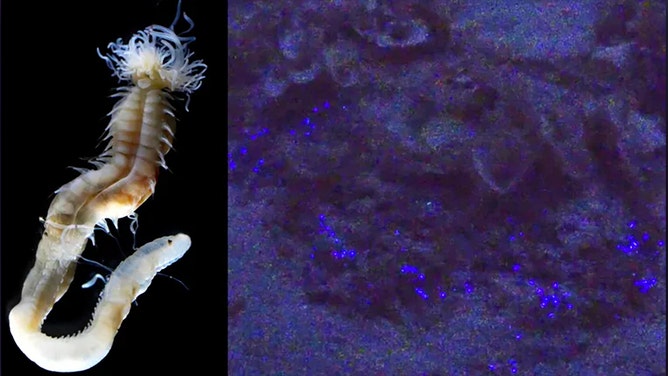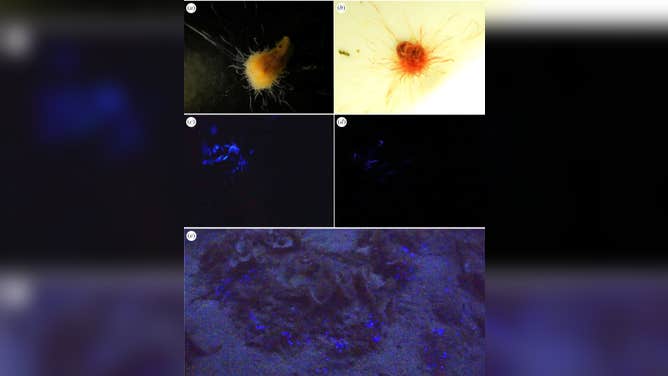Scientists discover 3 new sea worms that glow in the dark
The new bioluminescent Polycirrus worms, which emit a blue-violet light, were named after creatures from Japanese folklore, as well as an influential marine biologist, according to the team from Nagoya University in central Japan.

Polycirrus onibi, left, a newly discovered marine worm that glows in the dark, was named after a creature from Japanese folklore. The new species of luminescent Polycirrus worms that emit blue-purple light.
(Naoto Jimi / Nagoya University)
A group of researchers in Japan have discovered three new species of sea worms that quite literally glow in the dark.
The new bioluminescent Polycirrus worms, which emit a blue-violet light, were named after creatures from Japanese folklore, as well as an influential marine biologist, according to the team from Nagoya University in central Japan.
Bioluminescence is a result of a chemical reaction that produces light energy within an organism's body, according to Smithsonian Ocean. For the reaction to occur, a species must contain luciferin – a molecule that produces light when it reacts with oxygen.
There are more than 7,000 species of bioluminescent organisms in the world, but scientists have only studied a small fraction. The research team, led by two scientists from Nagoya University's Graduate School of Science, said science remains limited to only certain species because some are quite difficult to classify.
GLOWING REVIEW: EXPLORING THE BEAUTY OF BIOLUMINESCENCE
"Understanding these luminescence mechanisms contributes to medical and life science research. Bioluminescence is a treasure trove of interesting and unusual chemistry."
Study authors Naoto Jimi and Manabu Bessho-Uehara discovered that all three of these new species emit a blue-violet light in their underwater environments. Jimi said they were amazed by the discovery and felt a sense of duty to document and classify them.
"Our previous research on the luminescence of the genus Polycirrus had established it as a valuable subject for bioluminescence studies," Jimi said in a statement. "However, we later discovered what we thought was a single species of Polycirrus was actually three different species."
MESMERIZING VIDEO SHOWS VIBRANT AURORA DANCING ABOVE BIOLUMINESCENT WATER IN AUSTRALIA
The findings were published on March 29 in the journal Royal Society Open Science.
Newly discovered sea worms named after demon, ghost
After the discovery of the worms from different parts of Japan, the researchers opted to give them Japanese names.
Two of the three species were named Polycirrus onibi and Polycirrus aoandon as a reference to their bluish-violet luminescence, the team said.
In Japanese folklore, onibi ("demon fire") describes a will-o'-the-wisp type of yokai, shaped like a small, floating ball of light, that is believed to lead travelers in mountains and forests astray, according to the researchers.
Meanwhile, aoandon ("blue lantern") is a ghost-like yokai that appears as a woman wearing a white kimono with horns and sharp teeth. It haunts lanterns found in Japanese homes by turning their light an unnatural blue color, the team said.
'TRUE FORM OF MAGIC': GLOWING FUNGUS MAKES FOR SURREAL NEON SCENE ALONG DARK WASHINGTON BEACHES

Bioluminescence of Polycirrus spp. (a,c) Polycirrus onibi sp. nov.; (b,d) Polycirrus aoandon sp. nov.; (e) in situ observation of Polycirrus spp. (mixture of P. ikeguchii sp. nov. and P. onibi sp. nov., most of them are P. ikeguchii sp. nov.) at Notojima.
(Naoto Jimi / Nagoya University)
The third worm was named Polycirrus ikeguchii in honor of Shinichiro Ikeguchi, a notable Japanese marine biologist and former director of the Notojima Aquarium.
The researchers hope to use their findings to deepen their understanding of the molecular nature of bioluminescence, which could potentially lead to the development of new technologies.
"The discovery that all three new species are luminescent has allowed us to link taxonomic and ecological findings and establish research that others can readily apply to the study of luminescent organisms," Jimi said.
"Understanding these luminescence mechanisms contributes to medical and life science research," Jimi added. "Bioluminescence is a treasure trove of interesting and unusual chemistry."
This story was reported from Cincinnati.